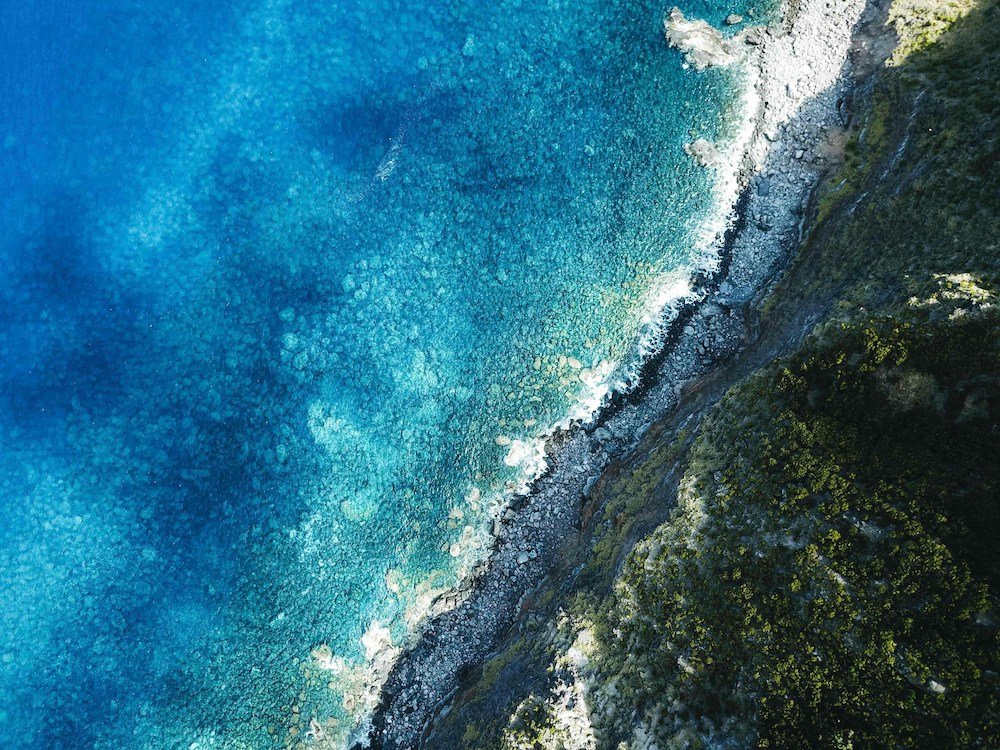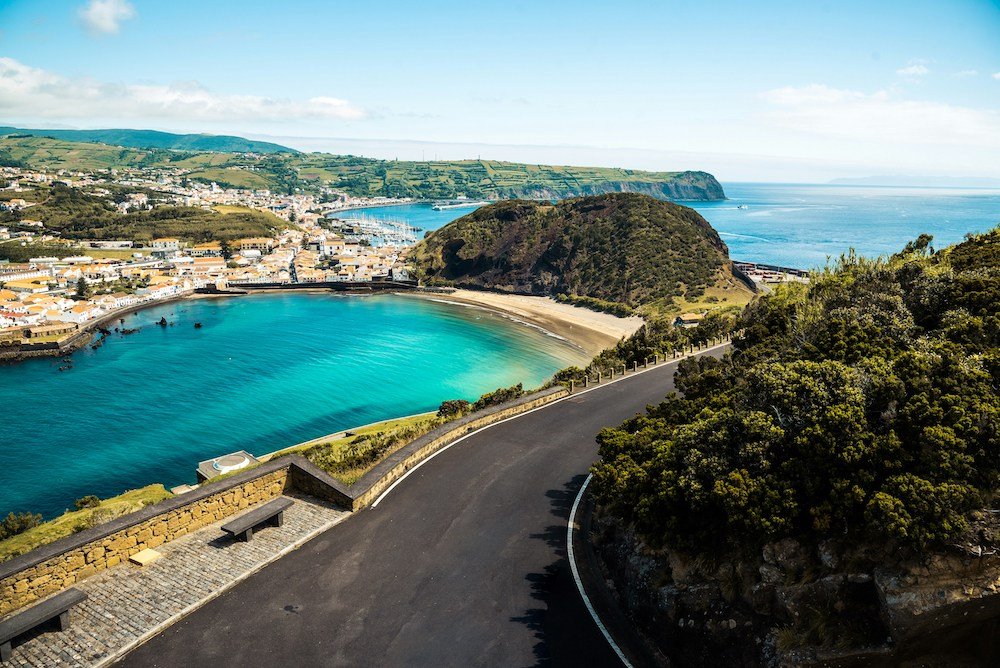
Want to discover what is the best Azores island to visit on your next holiday?
Nestled in the heart of the Atlantic Ocean, the Azores archipelago emerges as a breathtaking mosaic of nature’s finest work, a true hidden gem waiting to be discovered by the discerning traveler.
This enchanting group of nine islands, each with its own unique charm and character, offers an unparalleled experience of exploration, adventure, and tranquility.
From the lush, volcanic landscapes of São Miguel to the serene beauty of Flores, the Azores present a diverse canvas of natural wonders.
Choosing the best Azores island to visit is not merely about pinpointing a single destination on the map; it’s about matching the island’s personality with your travel desires and interests.
Whether you’re a nature enthusiast eager to traverse green mountains and dive into crystal-clear waters, a history buff fascinated by centuries-old villages and traditions, or someone looking to unwind in the tranquility of remote landscapes, there’s an island in the Azores calling your name.
Overview of the Azores
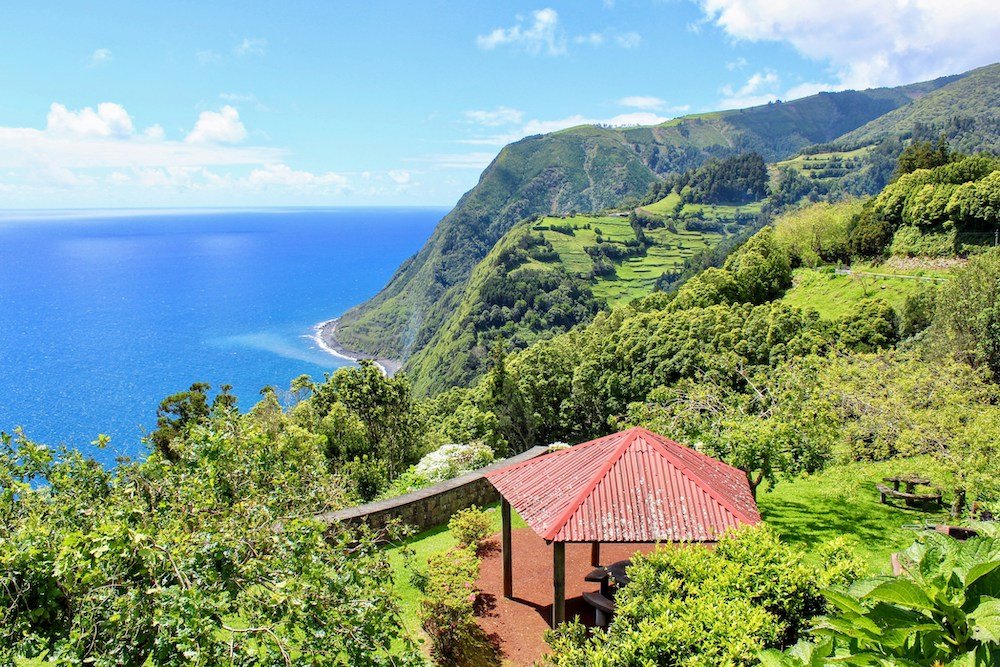
Nestled in the vast expanse of the Atlantic Ocean, halfway between Europe and North America, the Azores archipelago is a cluster of nine volcanic islands that boast a rich tapestry of natural landscapes, history, and culture.
This section delves into the historical and geographical context of the Azores, offers insights into its climate and the best times to visit, and highlights the cultural and linguistic richness that defines this unique region.
Brief History and Geographical Setting
Discovered in the 15th century by Portuguese navigators, the Azores quickly became an important stopover for ships traveling between Europe, Africa, and the Americas, playing a pivotal role in the Age of Discovery.
This strategic position has imbued the islands with a deep maritime heritage and a diverse cultural legacy, influenced by settlers and visitors from around the world.
Geographically, the Azores are situated on the triple junction between the North American, Eurasian, and African tectonic plates, giving rise to their dramatic landscapes of craggy peaks, serene lakes, and lush valleys.
Climate and the Best Times to Visit
The Azores enjoy a temperate maritime climate, with mild temperatures year-round, ranging from 16°C (61°F) in the winter to 25°C (77°F) in the summer.
The weather can be unpredictable, with the possibility of experiencing “four seasons in a day,” so visitors are advised to come prepared with layers.
The best time to visit the Azores is arguably from May to September when the weather is warmer, and the islands are in full bloom.
However, those looking to avoid the crowds while still enjoying pleasant weather might consider the shoulder seasons of April and October.
Cultural Highlights and Linguistic Insights
The culture of the Azores is a vibrant tapestry that weaves together elements of Portuguese traditions with local customs that have evolved on the islands.
Festivals and religious celebrations, such as the Holy Ghost Festival, play a central role in community life, showcasing the deep spiritual and communal bonds of the Azorean people.
Gastronomy is another highlight, with a focus on seafood, cheeses, and wines that reflect the islands’ volcanic soils and maritime climate.
Linguistically, Portuguese is the official language, but the Azorean dialect features unique expressions and accents, particularly on São Miguel and Terceira islands.
This linguistic diversity adds another layer of charm to exploring the Azores, making every conversation an opportunity to discover more about the islands’ heritage.
The best Azores island to experience a profound cultural immersion might depend on your interests, whether they lie in exploring historical sites, engaging with local traditions, or simply enjoying the natural beauty that surrounds you.
Each island offers a different slice of Azorean life, inviting visitors to explore and connect with its unique story.
Which Are The Best Azores Islands?
When it comes to identifying the best Azores island, the choice is deeply personal, reflecting each traveler’s interests and desires.
1. São Miguel – The Green Island

São Miguel, the largest island in the Azores, is a verdant paradise that offers a spectacular array of natural and cultural attractions.
Its nickname, The Green Island, barely scratches the surface of what visitors can expect to discover.
Famous for:
- Sete Cidades: This stunning volcanic caldera is home to two lakes, one green and one blue, surrounded by lush forests and rolling hills. The area’s breathtaking beauty can be explored through numerous hiking trails, offering some of the most iconic vistas in the Azores.
- Furnas: Known for its thermal springs and bubbling mud pots, Furnas is a testament to São Miguel’s volcanic activity. Visitors can relax in the warm, mineral-rich waters or enjoy a unique culinary experience with “cozido das Furnas,” a stew cooked underground by volcanic steam.
- Terra Nostra Park: A visit to this botanical garden is like stepping into a living painting. With its thermal pools, exotic plants, and meandering paths, Terra Nostra Park is a testament to the island’s natural beauty and the care taken to preserve it.
Best for:
- Nature Lovers: The diverse landscapes of São Miguel, from craters to coastlines, make it a playground for those who love to immerse themselves in nature. Hiking, bird watching, and simply basking in the island’s natural beauty are activities that can fill days on end.
- Hot Springs Enthusiasts: With its geothermal activity, São Miguel offers a unique wellness experience. The island’s hot springs, particularly in Furnas, provide a relaxing escape, allowing visitors to unwind in nature’s own spas.
- Foodies: The culinary scene in São Miguel is a delightful journey through local flavors and traditions. From seafood freshly caught in the Atlantic to the rich cheeses produced on the island, foodies will find themselves in a haven of taste experiences. The “cozido das Furnas” is a must-try, showcasing the island’s volcanic activity in the most delicious way possible.
São Miguel encapsulates the essence of the Azores, offering a blend of natural wonders, cultural experiences, and culinary delights.
It stands as a strong contender for the best Azores island for those seeking a comprehensive experience of what this remarkable archipelago has to offer.
2. Terceira – The Historical Island
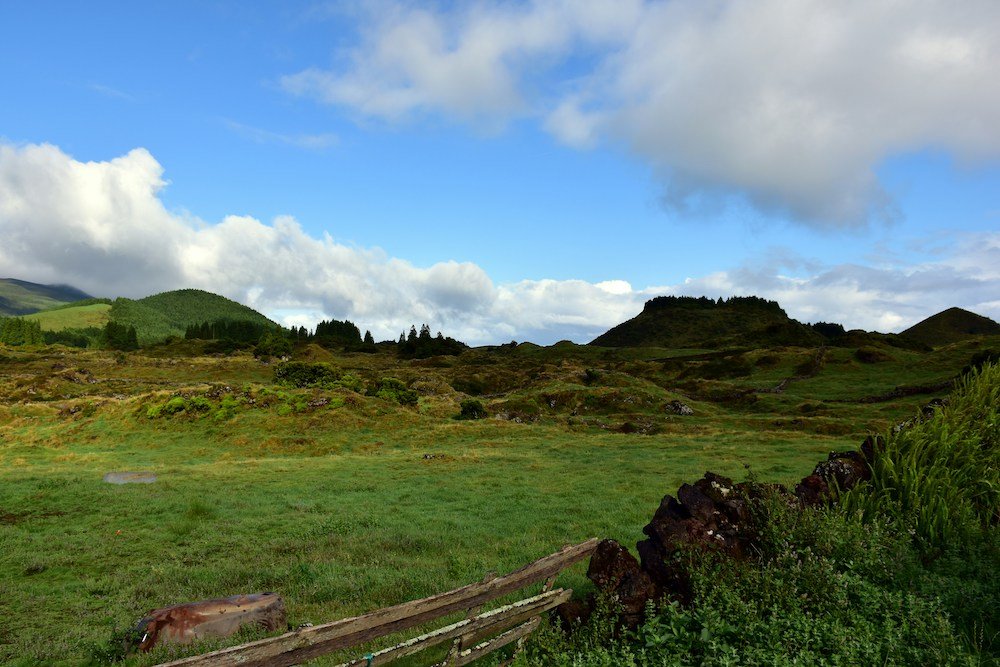
Among the jewels of the Azores, Terceira stands out as a beacon of history and culture, aptly nicknamed The Historical Island.
Its rich past and vibrant cultural tapestry offer a deep dive into the traditions and stories that have shaped not only the island but the entire archipelago.
Famous for:
- Angra do Heroísmo: This charming town is not just the historical capital of the Azores but also a UNESCO World Heritage Site, celebrated for its well-preserved Renaissance buildings, beautiful gardens, and significant maritime history. Strolling through its cobbled streets is like walking through a living museum, where each building and plaza tells a story of discovery, war, and peace.
- Algar do Carvão: A rare gem among volcanic caves, Algar do Carvão is an ancient lava tube that invites visitors into the heart of a volcano. Its interior is adorned with stalactites and stalagmites, and at the bottom, a clear, serene pool reflects the eerie beauty of this underground world. It’s a testament to the volcanic activity that has shaped these islands and a must-visit for anyone fascinated by the raw power of nature.
- Biscoitos Wine Region: Terceira is also home to the Biscoitos wine region, where the unique terroir produces distinctive wines that have been celebrated for centuries. The vineyards are set against a backdrop of dramatic lava rock formations, creating a landscape that is as visually stunning as it is agriculturally fertile. Wine enthusiasts will relish the opportunity to taste the local varietals, particularly the Verdelho, which has a rich history on the island.
Best for:
Terceira is the perfect destination for history buffs, cultural explorers, and geology enthusiasts.
Its blend of historical sites, natural wonders, and cultural experiences offers a rich itinerary for those looking to immerse themselves in the essence of the Azores.
From exploring the depths of a volcano to wandering the streets of a World Heritage Site and sipping local wines amidst the beauty of volcanic vineyards, Terceira encapsulates the spirit of discovery that defines the Azores.
Whether you’re delving into the storied past of Angra do Heroísmo, venturing into the heart of Algar do Carvão, or exploring the unique viticulture of the Biscoitos wine region, Terceira offers a glimpse into the layers of history, culture, and natural beauty that make the Azores a destination like no other.
3. Pico – The Mountainous Island
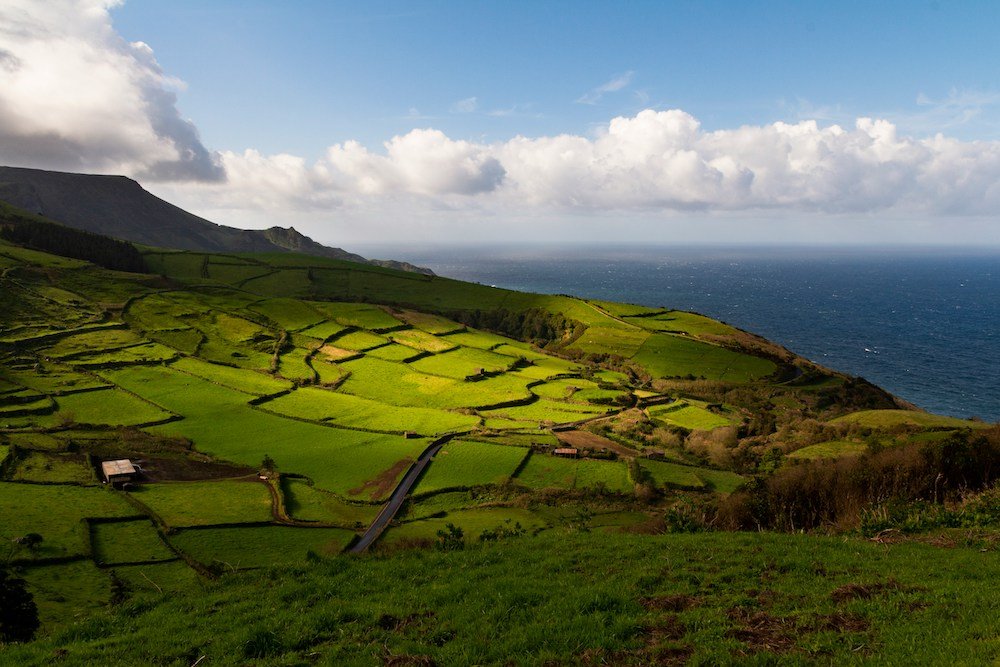
Pico, often referred to as The Mountainous Island, rises majestically from the Atlantic Ocean, its silhouette dominated by the towering Pico Mountain, the highest point in Portugal.
This island’s rugged landscape, rich vinicultural heritage, and vibrant marine life create a compelling destination for those seeking adventure, culture, and natural beauty.
Famous for:
- Pico Mountain: Standing at an impressive 2,351 meters (7,713 feet), Pico Mountain is not only a stunning natural landmark but also a beacon for hikers from around the world. The climb to its summit offers a challenging yet rewarding experience, with breathtaking views that span across the archipelago on clear days. It’s a journey through diverse ecosystems, leading adventurers from verdant forests to volcanic deserts, culminating in the surreal landscape of the crater’s edge.
- Vineyards: The volcanic soils of Pico provide a unique terroir for wine production, a tradition that dates back to the 15th century. The island’s vineyards, particularly those in the Pico Island Vineyard Culture, a UNESCO World Heritage Site, are famous for their distinctive layout among black lava rocks. These wines, especially the white Verdelho, have garnered international acclaim, reflecting the island’s rich vinicultural history and its adaptation to the challenging volcanic landscape.
- Whale Watching: Pico’s surrounding waters are a prime location for whale watching, offering one of the best vantage points in the Azores to observe these majestic creatures in their natural habitat. The island’s deep waters are frequented by a variety of whale species throughout the year, including sperm whales, blue whales, and fin whales, making it a haven for wildlife enthusiasts and nature lovers.
Best for:
Pico is an island that appeals to hikers, wine lovers, and wildlife enthusiasts alike.
The challenge and beauty of Pico Mountain attract those looking to conquer its peak, while the island’s unique vineyards offer a delightful experience for oenophiles.
Meanwhile, the opportunity to witness whales in their natural environment is a powerful draw for wildlife aficionados.
Whether scaling the heights of Pico Mountain, exploring the intricately laid vineyards, or embarking on a whale watching adventure, visitors to Pico are guaranteed an unforgettable experience that showcases the diverse appeal of the Azores.
The island’s combination of natural wonders and cultural heritage makes it a standout destination, embodying the adventurous spirit and natural beauty that define the archipelago.
4. Faial – The Blue Island
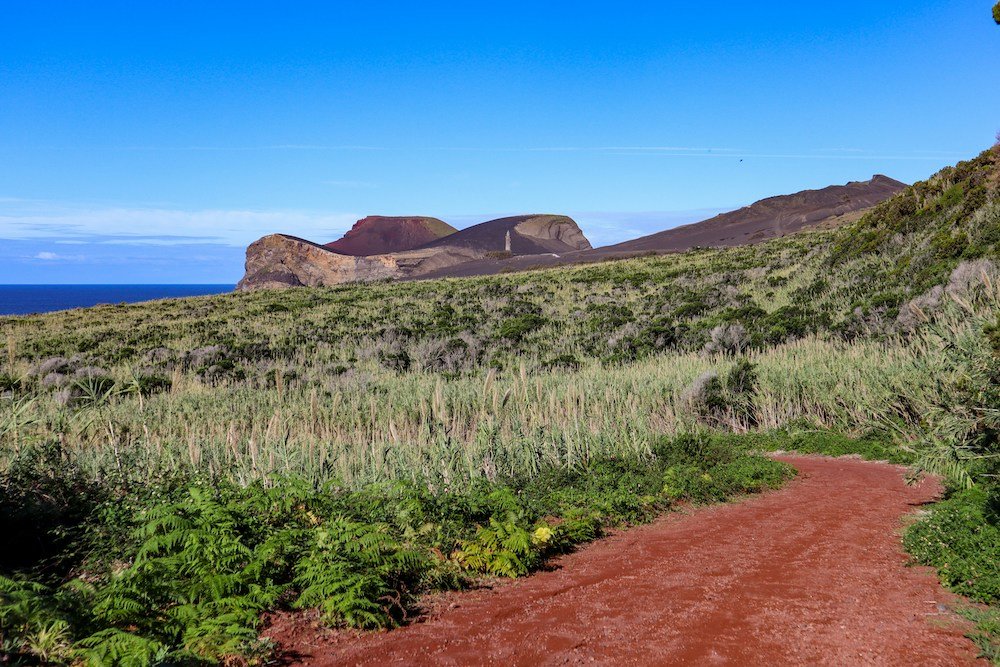
Faial captivates visitors with its vibrant blue hydrangeas, stunning natural landscapes, and rich maritime heritage.
Known affectionately as The Blue Island, Faial is a testament to the beauty and resilience of the Azores, offering a plethora of experiences for sailors, hikers, and nature enthusiasts alike.
Famous for:
- Horta Marina: A legendary stopover for transatlantic sailors, Horta Marina is not just a haven for yachtsmen and women but also a colorful tapestry of maritime history. The marina’s walls and walkways are adorned with paintings created by sailors from around the globe, each telling a story of adventure across the seas. Horta Marina is more than a place to moor; it’s a vibrant community hub where tales of the sea are shared and friendships are forged.
- Capelinhos Volcano: The Capelinhos Volcano is a stark reminder of the dynamic and ever-changing nature of the Azores. Its eruption in 1957-58 added new land to Faial and dramatically altered the island’s landscape. Today, the Capelinhos area offers a unique lunar landscape that contrasts sharply with the lush greenery typical of the Azores. The volcano’s visitor center provides a fascinating insight into the eruption, volcanic activity in the Azores, and the profound impact on the local community.
- Hydrangea Landscapes: In the summer months, Faial transforms into a sea of blue as hydrangeas bloom across the island. These flowers have become synonymous with Faial, lining roads and framing the island’s landscapes with their vibrant hues. The hydrangeas not only add to the island’s aesthetic appeal but also play a role in protecting its soil and contributing to its ecosystem.
Best for:
Faial is an island paradise for sailors, hikers, and nature lovers.
The island’s maritime culture and welcoming community make it a must-visit destination for those who love the sea.
The trails leading through its diverse landscapes, from the craters of dormant volcanoes to the serene beauty of its hydrangea-adorned pathways, offer hikers a range of experiences.
Meanwhile, nature lovers will find the island’s flora and unique geological features a constant source of wonder.
Whether you’re mooring at Horta Marina, exploring the ash-coated grounds of Capelinhos, or wandering through fields of blue hydrangeas, Faial embodies the essence of the Azores’ natural beauty and maritime spirit.
It’s an island where the blue of the sea meets the sky, and where adventurers and dreamers alike can find their haven.
5. São Jorge – The Rugged Island
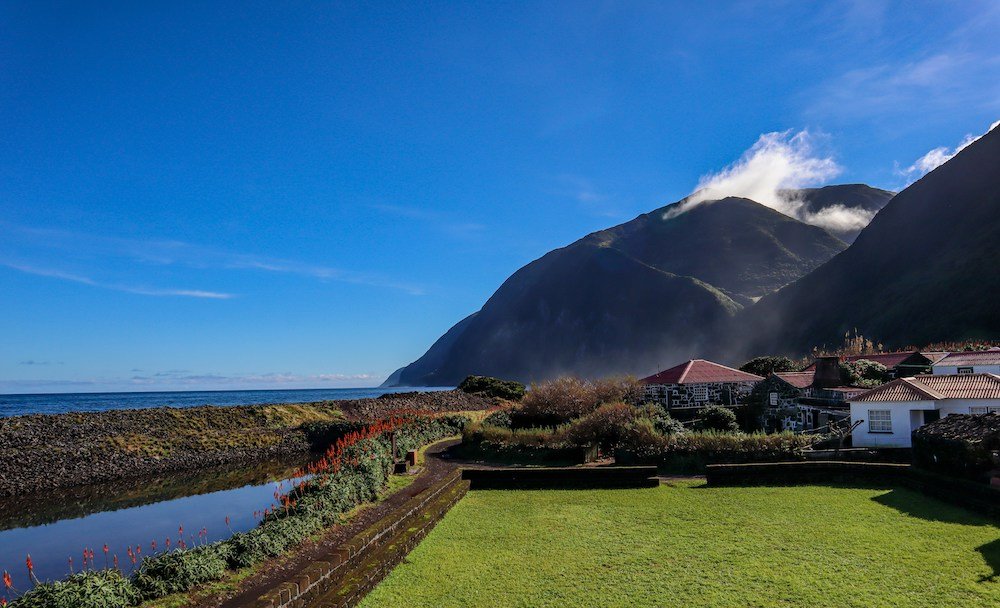
São Jorge, often celebrated as The Rugged Island, stands as a testament to the wild, untamed beauty of the Azores.
Its dramatic landscape, characterized by steep cliffs and the unique flat coastal areas known as fajãs, creates a striking contrast that beckons adventure travelers, foodies, and those seeking solitude.
Famous for:
- Fajãs: The fajãs of São Jorge are flat areas formed by lava flows or landslides at the base of cliffs, creating fertile ground that is utilized for agriculture and as unique locations for settlements. These remarkable geological formations offer not only stunning vistas but also a glimpse into the resilient way of life that has developed in harmony with the island’s natural forces. Hiking trails that meander through the fajãs reveal hidden waterfalls, secluded pools, and breathtaking coastal views.
- São Jorge Cheese: A culinary treasure of the Azores, São Jorge Cheese is a semi-hard, tangy cheese that has been produced on the island for over 500 years. Made from the raw milk of cows grazing on the island’s rich pastures, this cheese is renowned for its intense flavor and quality. Visiting the cheese factories on São Jorge provides an insight into the traditional methods of cheese production and offers the chance to savor this delicious local specialty.
- Unique Topography: The island’s rugged terrain, with its high cliffs and deep ravines, offers more than just scenic beauty. It’s a playground for adventure seekers, offering activities from cliff-top hiking and paragliding to exploring the numerous caves and tunnels formed by volcanic activity. São Jorge’s topography has shaped not only the landscape but also the character of its people and their way of life.
Best for:
Adventure travelers, foodies, and those seeking solitude will find São Jorge an ideal destination.
The island’s unique geography provides a backdrop for thrilling outdoor activities and exploration, while its culinary heritage offers a taste of the Azores that is both authentic and delicious.
For those looking to escape the hustle and bustle of everyday life, the tranquil fajãs and the serene beauty of São Jorge’s landscapes offer a perfect retreat into nature.
São Jorge invites visitors to immerse themselves in an island experience that is as diverse as it is compelling.
From the adrenaline of adventure to the quietude of its secluded spots and the delight of its culinary traditions, São Jorge embodies the spirit of exploration and the joy of discovery.
It’s an island where the rugged beauty of the Azores can be experienced in every vista, every bite, and every moment of solitude.
6. Graciosa – The White Island

Graciosa, affectionately known as The White Island due to its characteristic white houses and landscapes adorned with vineyards and windmills, is a haven of tranquility in the Azores.
This island offers a serene escape with its thermal springs, unique geological formations, and historical windmills, making it a perfect destination for relaxation seekers, nature enthusiasts, and history buffs.
Famous for:
- Furna do Enxofre: A remarkable natural cathedral, Furna do Enxofre is a large volcanic cave with a lake of crystal-clear water at its base. Accessible via a tunnel that leads to a spiral staircase, visitors are greeted by the sight of this majestic, sulfuric cave with its impressive stalactites and an underground lake. The natural light filtering through the opening at the top of the cave illuminates the interior, creating a mystical atmosphere that captivates all who enter.
- Thermal Springs: Graciosa is dotted with thermal springs, known for their therapeutic properties. The most famous of these is the Termas do Carapacho, located near the coast and offering stunning ocean views. These natural hot springs are said to have healing properties for various ailments, making them a sought-after destination for those looking to unwind and rejuvenate in the island’s peaceful surroundings.
- Windmills: The landscape of Graciosa is punctuated by traditional windmills, a testament to the island’s agricultural heritage and ingenuity. These iconic structures, with their distinctive red domes and white bodies, have been restored and preserved as symbols of Graciosa’s past. Visiting these windmills offers a glimpse into the island’s history and the traditional ways of milling grain, connecting visitors with the island’s cultural legacy.
Best for:
Relaxation seekers, nature enthusiasts, and history buffs will find Graciosa an enchanting destination.
The island’s thermal springs provide a natural spa experience, while the unique geological wonders like Furna do Enxofre offer a glimpse into the island’s volcanic origins.
The historical windmills scattered across the landscape not only add to the island’s charm but also offer insights into its past.
Graciosa invites visitors to step into a world where nature’s beauty is in harmony with historical heritage, offering a peaceful retreat away from the hustle and bustle of modern life.
Whether soaking in the healing waters of the thermal springs, exploring the depths of a volcanic cave, or marveling at the traditional windmills, Graciosa embodies the tranquil spirit and rich history of the Azores.
7. Flores – The Flower Island
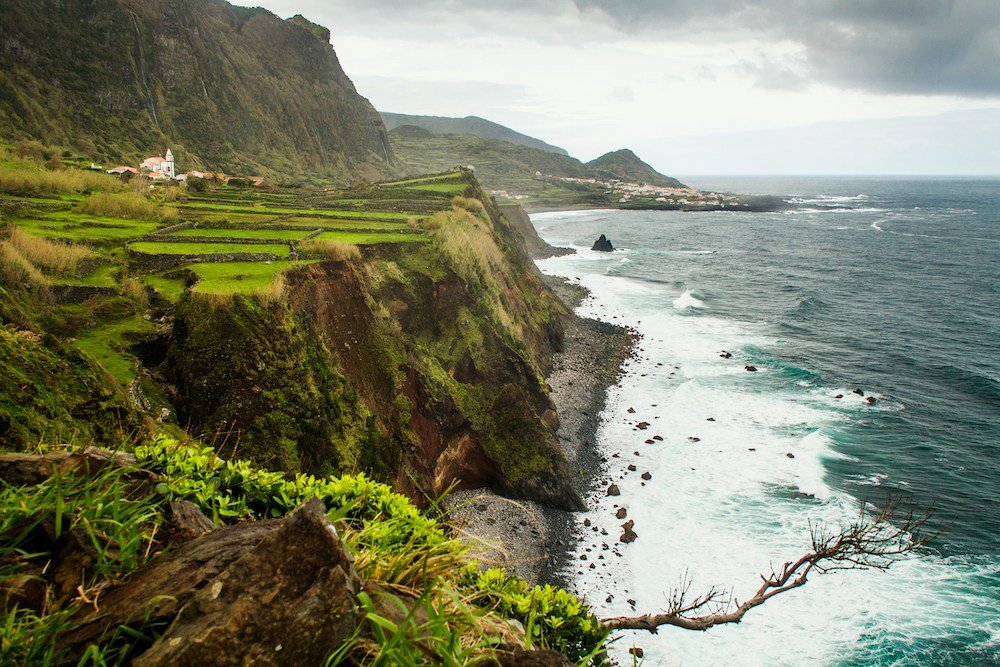
Flores, aptly named The Flower Island, bursts into a kaleidoscope of color each spring, with an abundance of flowers blanketing its landscapes.
This island, recognized as a UNESCO Biosphere Reserve, is a paradise for outdoor adventurers, photographers, and nature lovers, offering a wealth of stunning natural attractions from cascading waterfalls to crystal-clear lagoons.
Famous for:
- Lagoons: Flores is dotted with beautiful lagoons, nestled among lush green hills and ancient volcanic craters. These tranquil bodies of water, such as Lagoa dos Patos and Lagoa Comprida, offer serene settings for kayaking, swimming, or simply enjoying the peaceful ambience. The lagoons are also perfect subjects for photographers, reflecting the sky and surrounding landscapes in their clear waters.
- Waterfalls: Among the island’s most breathtaking natural features are its waterfalls, with the Cascata do Poço do Bacalhau and Cascata dos Ribeirão being two of the most spectacular. These waterfalls, fed by the island’s abundant rainfall, cascade down high cliffs into crystal-clear pools below, creating a mesmerizing spectacle that is a must-see for visitors.
- UNESCO Biosphere Reserve: Flores’s designation as a UNESCO Biosphere Reserve underscores its exceptional natural beauty and the importance of preserving its unique ecosystems. The island’s diverse habitats, from coastal areas to high-altitude cloud forests, support a wide range of flora and fauna, making it a haven for biodiversity. Hiking through the island’s trails offers the chance to witness this ecological richness firsthand, with opportunities to spot rare bird species and endemic plants.
Best for:
Outdoor adventurers, photographers, and nature lovers will find Flores an unparalleled destination.
The island’s rugged landscapes and abundant natural beauty provide endless opportunities for exploration and photography, from hiking to remote lagoons and waterfalls to capturing the stunning vistas that unfold around every corner.
Flores invites visitors to immerse themselves in its natural wonders, whether it’s trekking through lush forests, marveling at the power of its waterfalls, or simply enjoying the tranquility of its lagoons.
It’s an island where the beauty of nature is evident in every bloom, every drop of water, and every panoramic view, making it a true paradise for those who cherish the outdoors.
8. Corvo – The Small Island
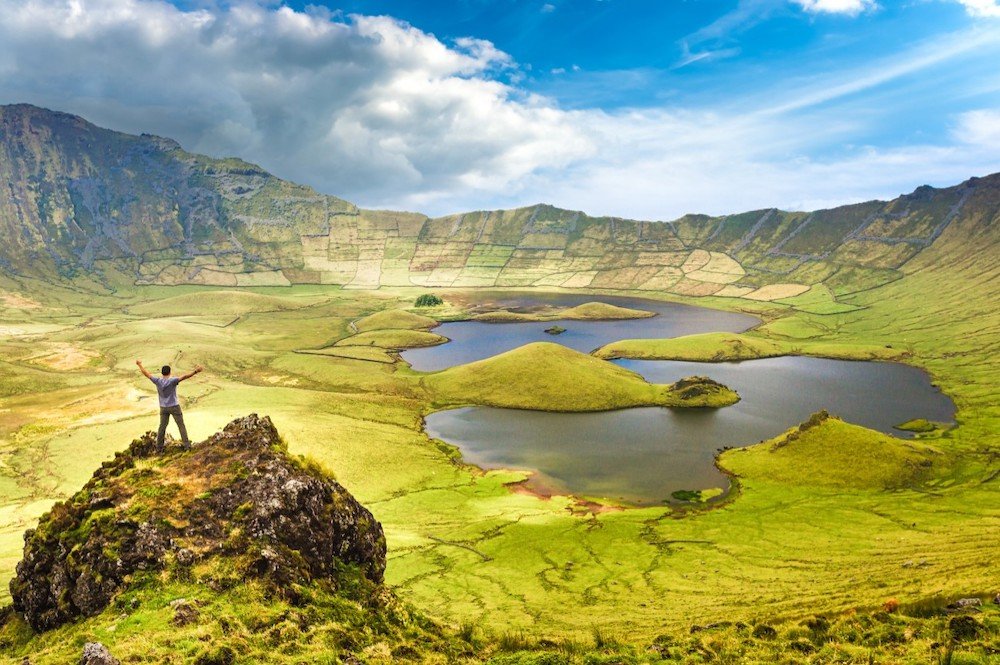
Corvo, the smallest island in the Azores archipelago, is a hidden gem offering an intimate encounter with nature’s unspoiled beauty.
Known as The Small Island, Corvo is a sanctuary of tranquility and pristine landscapes, making it an ideal destination for bird watchers, hikers, and anyone seeking a remote escape.
Famous for:
- Caldeirão Crater: Dominating the island’s landscape, the Caldeirão Crater is a massive volcanic caldera that offers breathtaking views both from its rim and within its basin. Inside the crater, small lakes and peat bogs create a unique ecosystem, while the surrounding cliffs are adorned with lush vegetation. Hiking to the crater’s edge reveals the stunning panorama of this geological wonder, encapsulating the raw beauty of Corvo.
- Birdwatching: Corvo is a renowned hotspot for birdwatching, especially during the migration seasons when rare and exotic bird species can be spotted. Its remote location in the Atlantic makes it a resting point for many migratory birds crossing the ocean, providing bird enthusiasts with the opportunity to observe species not commonly seen in mainland Europe or North America. The island’s unspoiled habitats support a diverse avian population, making it a paradise for ornithologists and nature lovers alike.
Best for:
Bird watchers, hikers, and those looking for a remote escape will find Corvo an enchanting retreat.
The island’s compact size and low population density offer a sense of solitude and connection with nature that is increasingly rare in today’s world.
For bird watchers, Corvo presents an unparalleled opportunity to engage with the avian world in a setting that feels worlds away from the hustle and bustle of daily life.
Hikers will appreciate the rugged beauty of the landscape, with trails leading to the Caldeirão crater and along coastal cliffs offering stunning views of the Atlantic.
Corvo invites visitors to step off the beaten path and into a world where nature reigns supreme.
It’s a place where the simplicity of island life and the majesty of the natural world converge, offering a tranquil haven for those seeking to recharge and reconnect with the great outdoors.
9. Santa Maria – The Beach Island
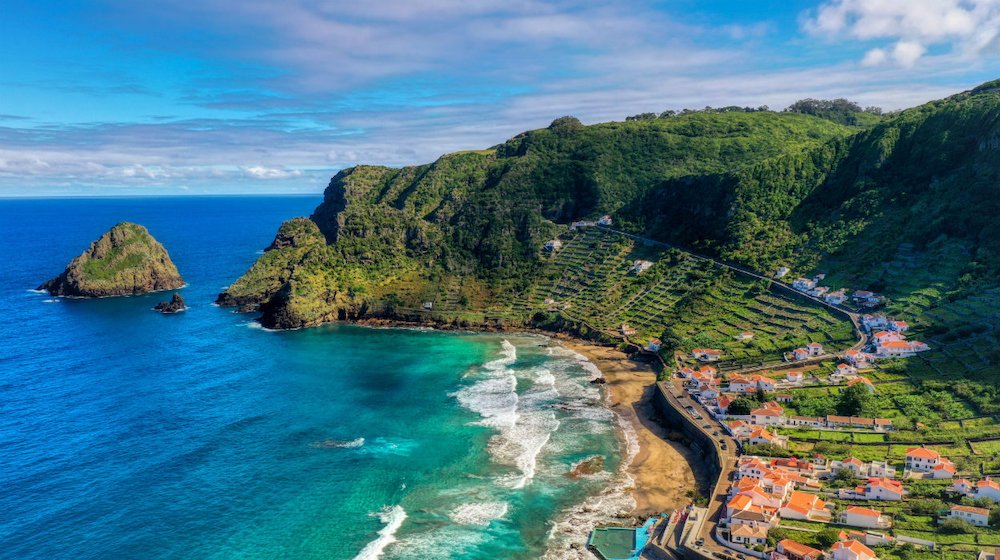
Santa Maria, affectionately known as The Beach Island, stands out in the Azores for its warmer climate, distinct geological features, and, most notably, its stunning white sandy beaches.
This island offers a blend of natural beauty, cultural heritage, and leisurely pursuits, making it a favorite destination for beachgoers, sun seekers, and cultural enthusiasts.
Famous for:
- White Sandy Beaches: Unlike the volcanic black sand beaches common in the Azores, Santa Maria boasts rare white sandy beaches, with Praia Formosa being the most celebrated. This beach is a haven for sunbathers and swimmers, offering crystal-clear waters and expansive stretches of soft sand. It’s also a popular spot for surfing and other water sports, providing the perfect setting for a day under the sun.
- Traditional Festivals: Santa Maria’s cultural calendar is rich with traditional festivals that offer a glimpse into the island’s vibrant community life. The Festival da Praia, for example, combines beachside entertainment with live music, local cuisine, and traditional dances, drawing visitors and locals alike. These festivals are a colorful display of Santa Maria’s traditions and a testament to the island’s strong sense of community and heritage.
- Chapel of Nossa Senhora dos Anjos: Among the island’s historical treasures is the Chapel of Nossa Senhora dos Anjos, believed to be the first chapel built in the Azores. This modest yet significant structure is where Christopher Columbus and his crew attended mass on their return from America. Visiting this chapel offers a unique connection to the island’s, and indeed the world’s, history, adding a layer of depth to the Santa Maria experience.
Best for:
Beachgoers, sun seekers, and cultural enthusiasts will find Santa Maria an idyllic destination.
The island’s beautiful beaches provide the perfect backdrop for relaxation and water sports, while the lively festivals immerse visitors in local traditions and festivities.
The historical sites, like the Chapel of Nossa Senhora dos Anjos, offer a quiet reflection on the island’s past and its role in the broader tapestry of history.
Santa Maria invites visitors to bask in its natural beauty, from the unique allure of its sandy shores to the warmth of its people and their customs.
It’s an island where leisure and culture blend seamlessly, offering a sun-soaked retreat enriched with moments of cultural discovery and historical wonder.
Comparative Analysis of the Azores
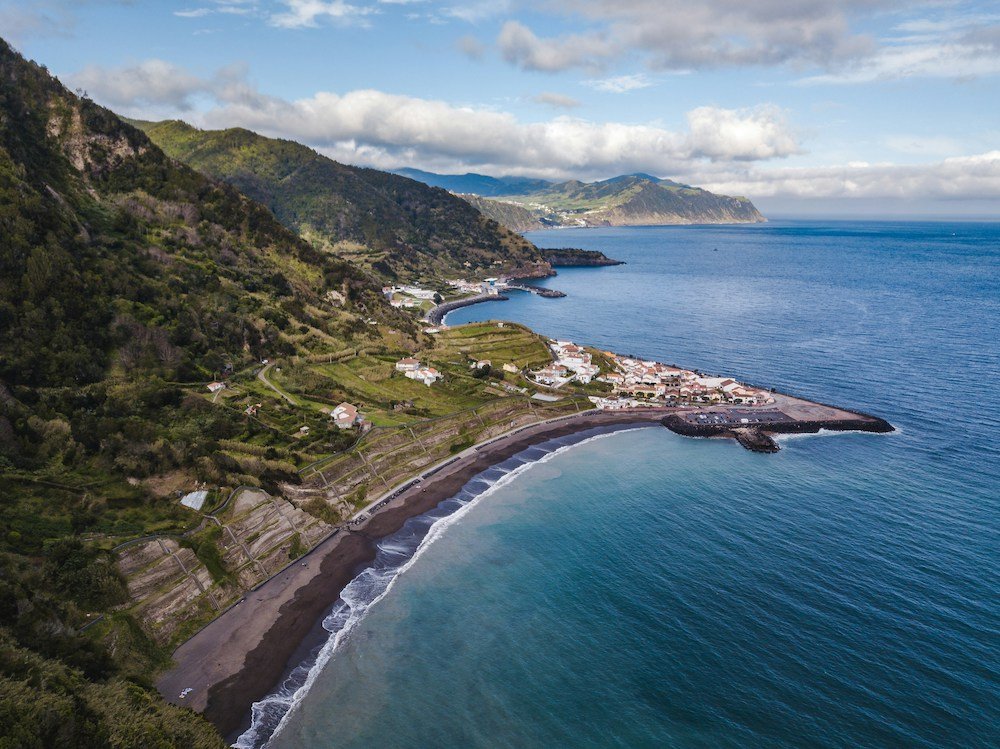
Choosing the best Azores island for your vacation depends on various factors, including the type of natural beauty and landscapes you prefer, the activities and attractions you enjoy, how easy it is to get there and get around, and the accommodation options available.
Here’s a side-by-side comparison to help you decide:
Natural Beauty and Landscapes
- São Miguel: Lush green landscapes, volcanic craters, and hot springs.
- Terceira: Historic charm with a mix of geological wonders and cultural heritage.
- Pico: Dominated by the majestic Pico Mountain and surrounded by vineyards.
- Faial: Known for its hydrangeas, volcanic landscapes, and the marina.
- São Jorge: Rugged terrain featuring dramatic cliffs and unique fajãs.
- Graciosa: Tranquil beauty with rolling hills, windmills, and thermal springs.
- Flores: Abundant waterfalls, lagoons, and a rich, floral landscape.
- Corvo: Remote and unspoiled, home to the breathtaking Caldeirão crater.
- Santa Maria: Arid compared to other islands, famous for its white sandy beaches.
Activities and Attractions
- São Miguel: Hot springs, whale watching, and hiking.
- Terceira: UNESCO sites, wine tasting, and caving.
- Pico: Mountain climbing, wine tours, and whale watching.
- Faial: Sailing, visiting the Capelinhos Volcano, and hiking.
- São Jorge: Cheese tasting, hiking the fajãs, and cliff diving.
- Graciosa: Relaxing in thermal pools, exploring caves, and windmill visits.
- Flores: Nature hikes, bird watching, and photography.
- Corvo: Bird watching, hiking, and experiencing remote island life.
- Santa Maria: Beach activities, cultural festivals, and historical sites.
Accessibility and Travel Logistics
- São Miguel and Terceira: Easier to reach with direct flights from Europe and North America.
- Pico, Faial, and São Jorge: Accessible via inter-island flights and ferries, especially from São Miguel and Terceira.
- Graciosa, Flores, Corvo, and Santa Maria: Smaller airports, primarily served by inter-island flights, with fewer international connections.
Accommodation Options
- São Miguel and Terceira: Wide range of options from luxury hotels to guesthouses.
- Pico, Faial, and São Jorge: Good selection of mid-range and local accommodations.
- Graciosa, Flores, Corvo, and Santa Maria: More limited but offer a chance for intimate, local experiences.
Tips on Choosing the Right Island Based on Interests
- For Hiking: São Miguel, Pico, and Flores offer stunning trails.
- For History: Terceira’s Angra do Heroísmo is a must-visit.
- For Relaxation: Graciosa and Santa Maria provide serene environments.
- For Adventure: São Jorge and Faial cater to thrill-seekers.
- For Nature and Solitude: Corvo and Flores are perfect getaways.
- For Beaches: Santa Maria boasts the best sandy beaches.
When selecting the best Azores island for your trip, consider what experiences you want to prioritize.
Whether it’s soaking in natural hot springs, exploring historical sites, or lounging on pristine beaches, each Azores island offers a unique slice of paradise.
Practical Information for Visitors
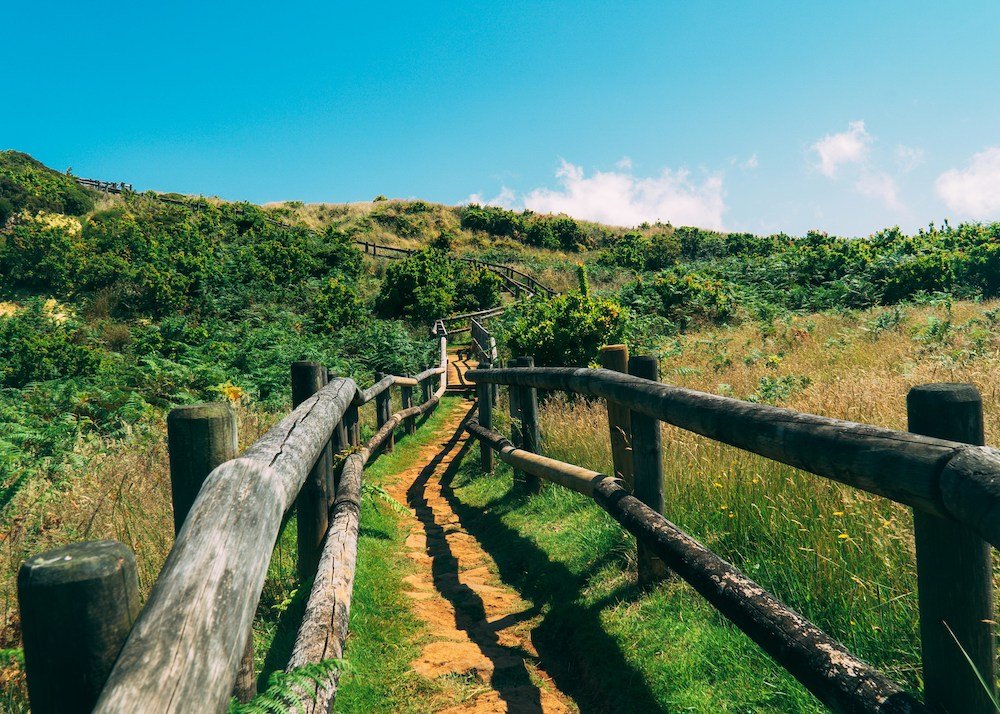
Visiting the Azores offers an opportunity to experience the unique blend of Portuguese culture and the islands’ distinctive charm.
Here are some practical tips to help you navigate your journey, respect local customs, and ensure a memorable and responsible visit.
Travel Tips for Getting to and Around the Azores
- Getting There: The Azores are accessible by air, with direct flights from major cities in Europe, the United States, and Canada to São Miguel and Terceira. Inter-island flights connect the rest of the archipelago, making island hopping convenient.
- Getting Around: Renting a car is the most flexible way to explore the islands, allowing you to discover hidden gems at your own pace. Public transport exists but is limited. Taxis and ride-sharing services are available in larger towns. Ferries between islands are an option during the warmer months, offering a scenic way to travel.
Cultural Etiquette and Sustainability Practices
- Cultural Etiquette: The Azoreans are known for their warm hospitality. Greet people with a polite “Bom dia” (Good morning), “Boa tarde” (Good afternoon), or “Boa noite” (Good evening). Dress modestly when visiting churches, and always ask permission before photographing locals.
- Sustainability Practices: Respect the natural environment by staying on marked trails, disposing of waste properly, and using eco-friendly sunscreens. Support local businesses by purchasing local products and dining at local restaurants. Participate in eco-tours and activities that promote conservation efforts.
Seasonal Considerations and What to Pack
- When to Visit: The best time to visit the Azores is from May to September when the weather is warmest and the islands are in bloom. However, the Azores offer unique experiences year-round, with fewer tourists and lower prices in the shoulder seasons (March-April and October-November).
- What to Pack: The weather in the Azores can be unpredictable, so pack layers that can be easily added or removed. Waterproof jackets and sturdy walking shoes are essentials for exploring the outdoors. Don’t forget a swimsuit for thermal pools and beaches, and bring a camera to capture the stunning landscapes. For hiking, pack a reusable water bottle and eco-friendly snacks.
Health and Safety
- Health: The Azores are safe with high standards of hygiene and healthcare. Tap water is generally safe to drink, but bottled water is recommended in remote areas. Health insurance that covers international travel is advised.
- Safety: The Azores are considered very safe for travelers. However, always take normal precautions to secure your belongings and stay informed about local conditions, especially when hiking or engaging in water sports.
Conclusion
The Azores, a breathtaking archipelago in the heart of the Atlantic Ocean, presents a mosaic of experiences, each island offering its own unique slice of paradise.
From São Miguel’s lush landscapes and thermal pools to the historical allure of Terceira, the dramatic peaks of Pico, Faial’s vibrant marina, São Jorge’s rugged beauty, Graciosa’s serene charm, Flores’s floral splendor, Corvo’s untouched natural wonders, and Santa Maria’s sun-kissed beaches, the Azores cater to every type of traveler.
Whether you’re an outdoor adventurer, a history enthusiast, a nature lover, or simply seeking relaxation, these islands promise unforgettable experiences.
We encourage you to explore the Azores, to immerse yourself in the stunning natural beauty, rich culture, and warm hospitality that define these islands.
As you plan your journey, remember to respect the delicate balance of the ecosystems and the traditions that make the Azores so special.
Embrace the opportunity to connect with nature, to learn from the local communities, and to contribute positively to the sustainability of this incredible destination.
Now is the time to start planning your visit to the Azores.
Choose the island that resonates most with your interests and preferences, and prepare for an adventure that will leave you with memories to last a lifetime.
Whether you’re drawn to the allure of volcanic landscapes, the charm of ancient traditions, or the tranquility of secluded beaches, the Azores await with open arms and endless possibilities.
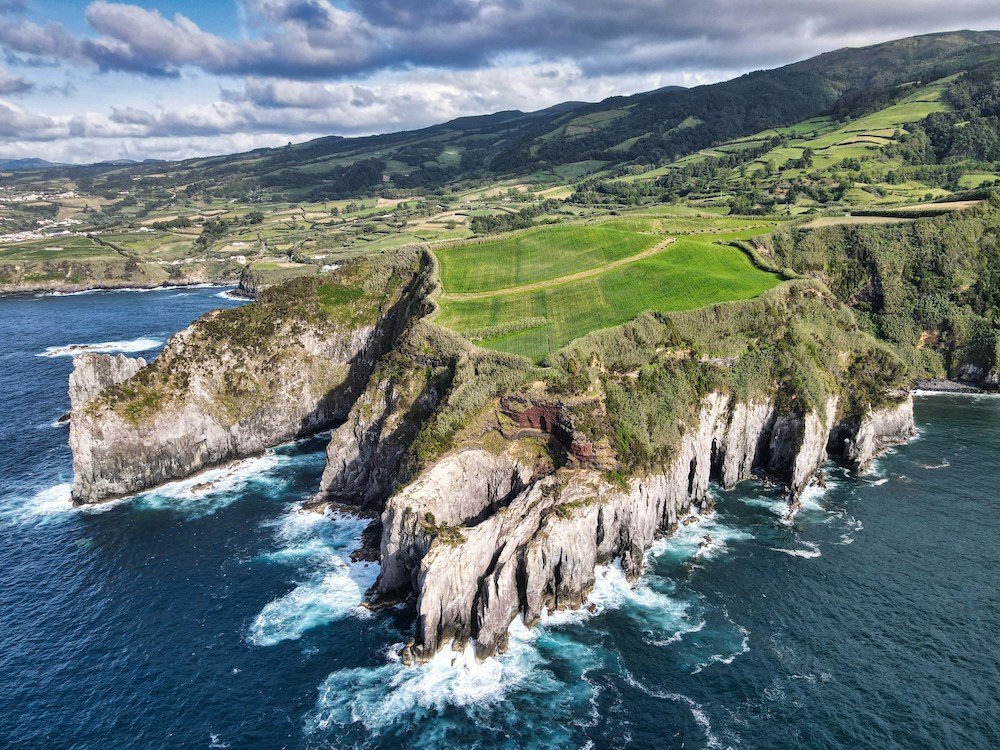
FAQ’s About the Best Azores Islands:
Which of the Azores is the best?
The best Azores island truly depends on what you’re looking for in a vacation.
São Miguel, the largest island, is often considered a favorite due to its wide range of attractions, including stunning landscapes, hot springs, and vibrant towns.
However, each island has its unique charm and specialties, making “the best” a highly subjective choice.
What is the most beautiful island in the Azores?
Beauty is subjective, but Flores is frequently hailed as the most beautiful island in the Azores due to its abundant flowers, breathtaking waterfalls, and picturesque lagoons.
Its status as a UNESCO Biosphere Reserve further underscores its natural beauty.
Which Azores island has the most to do?
São Miguel is generally considered the Azores island with the most activities and attractions.
It offers everything from hiking and whale watching to visiting tea plantations and enjoying thermal baths, making it a versatile destination for various interests.
Which Azores island has best beaches?
Santa Maria is renowned for having the best beaches in the Azores, with Praia Formosa being a standout for its long stretch of white sand and clear waters, a rarity in the predominantly rocky archipelago.
How many days is enough in Azores?
A minimum of 7 days is recommended to explore the Azores, allowing for a couple of days on São Miguel and brief visits to one or two other islands.
However, 10 to 14 days would provide a more relaxed pace to discover multiple islands without rushing.
Which island is better Madeira or Azores?
Madeira and the Azores offer different experiences.
Madeira is known for its lush landscapes, levada walks, and vibrant cultural scene.
In contrast, the Azores appeal to those seeking unspoiled nature, outdoor adventures, and a slower pace of life.
The choice between them depends on personal preferences in activities and atmosphere.
Are Azores expensive?
The cost of visiting the Azores can vary, but it is generally considered moderately expensive.
Prices for food, accommodation, and activities are comparable to mainland Portugal but can be higher due to the islands’ remote location. Planning and booking in advance can help manage costs.
What is the best month to visit Azores?
The best months to visit the Azores are May through September when the weather is warmer and drier, and the islands are lush and vibrant.
July and August offer the best chances for sunny days but also attract the most tourists.
Is Azores cheaper than Portugal?
The cost of living and visiting the Azores is somewhat comparable to mainland Portugal, with some items and services being more expensive due to the islands’ remoteness.
Generally, daily expenses in the Azores might be slightly higher, but the difference is not significantly large.
